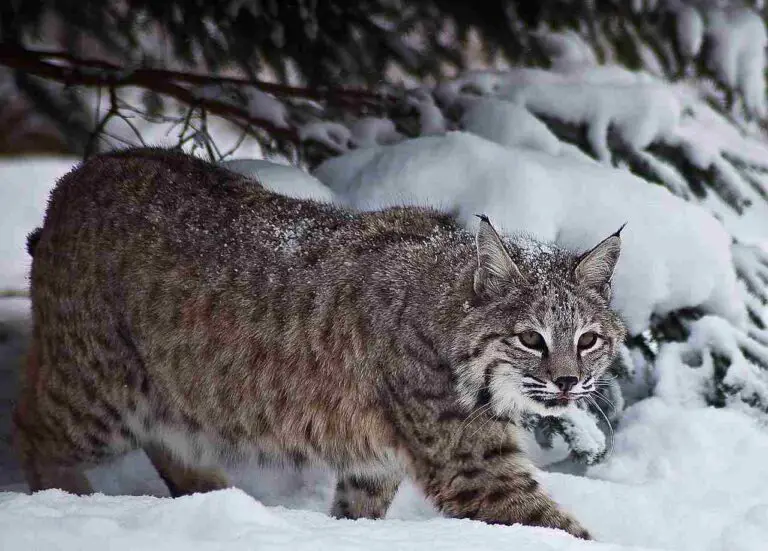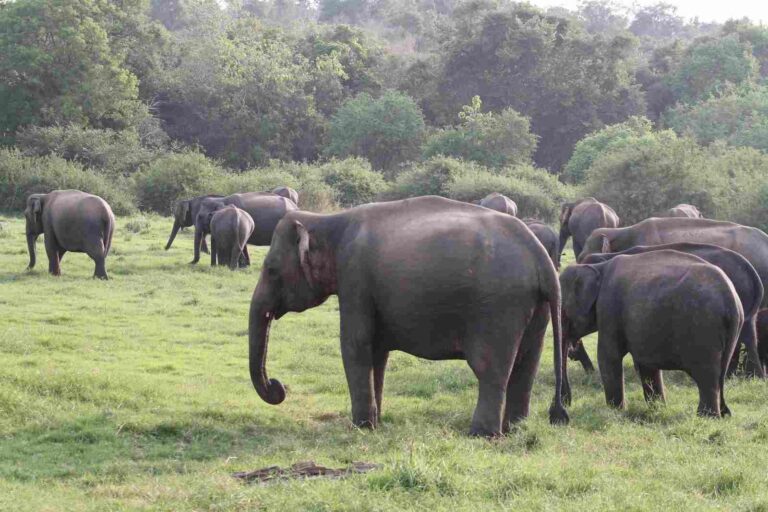Sun Bear Vs Moon Bear Size, Weight, Overall Comparison
In a theoretical clash between a sun bear and a moon bear, both belonging to the Ursidae family, we delve into the potential dynamics of this encounter, considering the notable size and weight distinctions within bear species. This analysis aims to elucidate why a moon bear might hold the upper paw in a confrontation with a sun bear, given its larger size and weight.
Sun Bear vs Moon Bear: Evaluating the Likely Winner in a Clash
In a hypothetical confrontation involving a sun bear and a moon bear, the outcome of a physical encounter hinges on the considerable size and weight variations within the Ursidae family. While both are formidable creatures, the moon bear’s larger build could be a decisive factor in determining the victor.
I). Size and Weight Disparities:
– Bears within the Ursidae family exhibit significant differences in size and weight. Sun bears, being the smallest bear species, typically weigh between 27 to 80 kg, while moon bears, also known as Asiatic black bears, can weigh between 60 to 200 kg. These substantial disparities in size and weight underscore the diversity within the bear family.
II). Individual and Species-Specific Traits:
– Individual and species-specific traits play a pivotal role in shaping the outcome of a confrontation between a sun bear and a moon bear. Despite both belonging to the Ursidae family, the moon bear’s larger size and weight may provide a distinct advantage in a physical altercation.
III). Moon Bear’s Superior Physical Attributes:
– Moon bears, characterized by their robust build and larger stature, possess superior physical attributes compared to sun bears. The moon bear’s larger size and weight contribute to its overall strength, potentially giving it an edge in a confrontation.
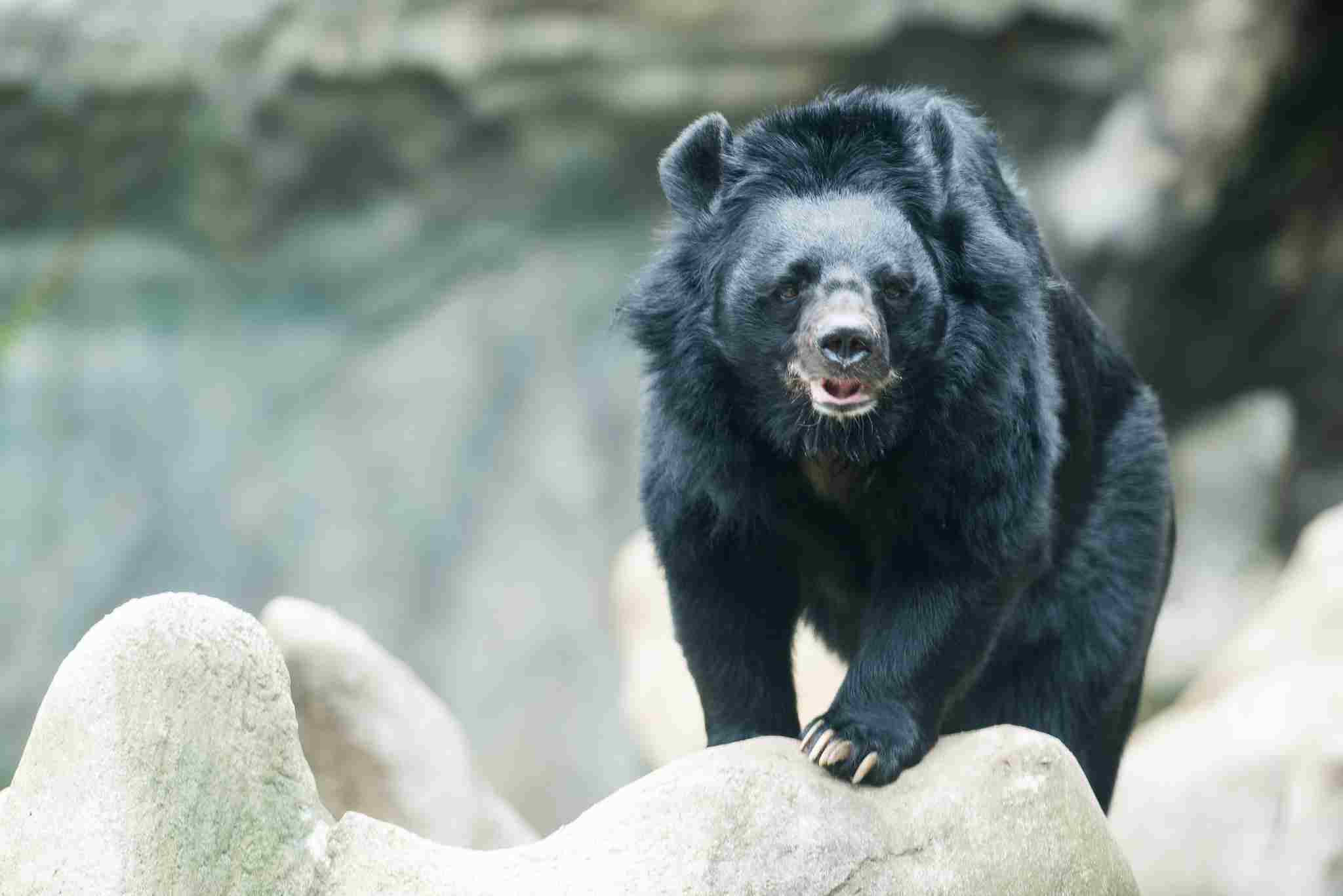
IV). Potential Strategies of the Sun Bear:
– Sun bears, although smaller in size, are known for their agility and climbing abilities. The sun bear’s potential strategies, such as evading direct confrontation and utilizing its agility, may be crucial in attempting to offset the moon bear’s size advantage.
V). Overall Dynamics:
– In this hypothetical scenario, the moon bear is likely to prevail in a clash with a sun bear due to its larger size and weight. However, the sun bear’s potential strategies and individual variations within the Ursidae family could influence the dynamics of the encounter.
*Details of Comparison
| Criteria | Sun Bear | Moon Bear |
| Taxonomy | Helarctos malayanus |
Ursus thibetanus
|
| Appearance | Short, sleek fur, distinctive chest marking |
Shaggy black fur, V-shaped chest mark, larger build
|
| Size | 120-150 cm (length) |
120-190 cm (length)
|
| Weight | 27-80 kg | 60-200 kg |
| Bite Force (PSI) | Moderate (estimated) | Strong |
| Physical Offensive Advantages | Climbing adaptations, efficient insect extraction |
Powerful limbs, claws for digging and climbing
|
| Physical Defensive Advantages | Agile climbing, defensive claws |
Strong build, defensive limbs
|
| Speed | Approximately 40 km/h (25 mph) |
Agile and quick, not precisely measured
|
| Agility | Agile climber, dense vegetation navigator |
Agile climber and swimmer
|
| Overall Physical Capacity | Climbing specialization |
Versatile – digging, climbing, swimming
|
| Habitat Preference(s) | Dense tropical rainforests |
Diverse habitats, adaptable
|
| Tracks | Claw marks, climbing adaptations |
Large, rounded tracks, powerful limbs
|
| Lifespan | Approximately 25-30 years (captivity) |
Around 25 years (wild)
|
| Mode of Feeding | Omnivorous – fruits, insects, small mammals |
Omnivorous – fruits, nuts, insects, small mammals
|
| Intelligence | Problem-solving skills, tool usage |
Highly intelligent, complex task learning
|
| Social Behavior | Generally solitary, some social interactions |
Typically solitary, social during mating and with cubs
|
| Mode of Reproduction | Seasonal breeding, one or two cubs |
Variable breeding season, one or two cubs
|
| Parental Behavior | Maternal care, females primary caregivers |
Mothers provide care and protection
|
| Proximity to Human-Inhabited Areas | Found near human settlements, especially in fragmented habitats |
May inhabit areas near humans, adaptable
|
| Behavior Toward Humans | Generally shy, may exhibit aggression if threatened |
Typically shy, defensive if provoked
|
| Danger Posed to Humans | Low risk, attacks rare |
Low risk, attacks infrequent
|
| Associated Precautions | Conservation efforts include habitat protection, reducing conflicts, and public awareness |
Conservation measures include habitat preservation, reducing illegal hunting, and mitigating human-bear conflicts
|
| Conservation Status | Vulnerable on the IUCN Red List |
Vulnerable on the IUCN Red List
|
| Conclusion (Similarities) |
Family (Ursidae), omnivorous diets, reproductive strategies, vulnerability (conservation status)
|
|
| Conclusion (Differences) |
Physical characteristics, size, habitat preferences, intelligence, and specific ecological adaptations
|
Key Takeaways
- Both sun bears and moon bears share the Ursidae family, omnivorous diets, similar reproductive strategies, and vulnerability, classified as vulnerable on the IUCN Red List.
- Key differences lie in their physical characteristics, size, habitat preferences, intelligence levels, and specific ecological adaptations, influencing their roles within ecosystems.
1. Taxonomy
Sun Bear (Helarctos malayanus)
Kingdom: Animalia
Phylum: Chordata
Class: Mammalia
Order: Carnivora
Family: Ursidae
Genus: Helarctos
Species: malayanus
Moon Bear (Ursus thibetanus)
Kingdom: Animalia
Phylum: Chordata
Class: Mammalia
Order: Carnivora
Family: Ursidae
Genus: Ursus
Species: thibetanus
2. Appearance
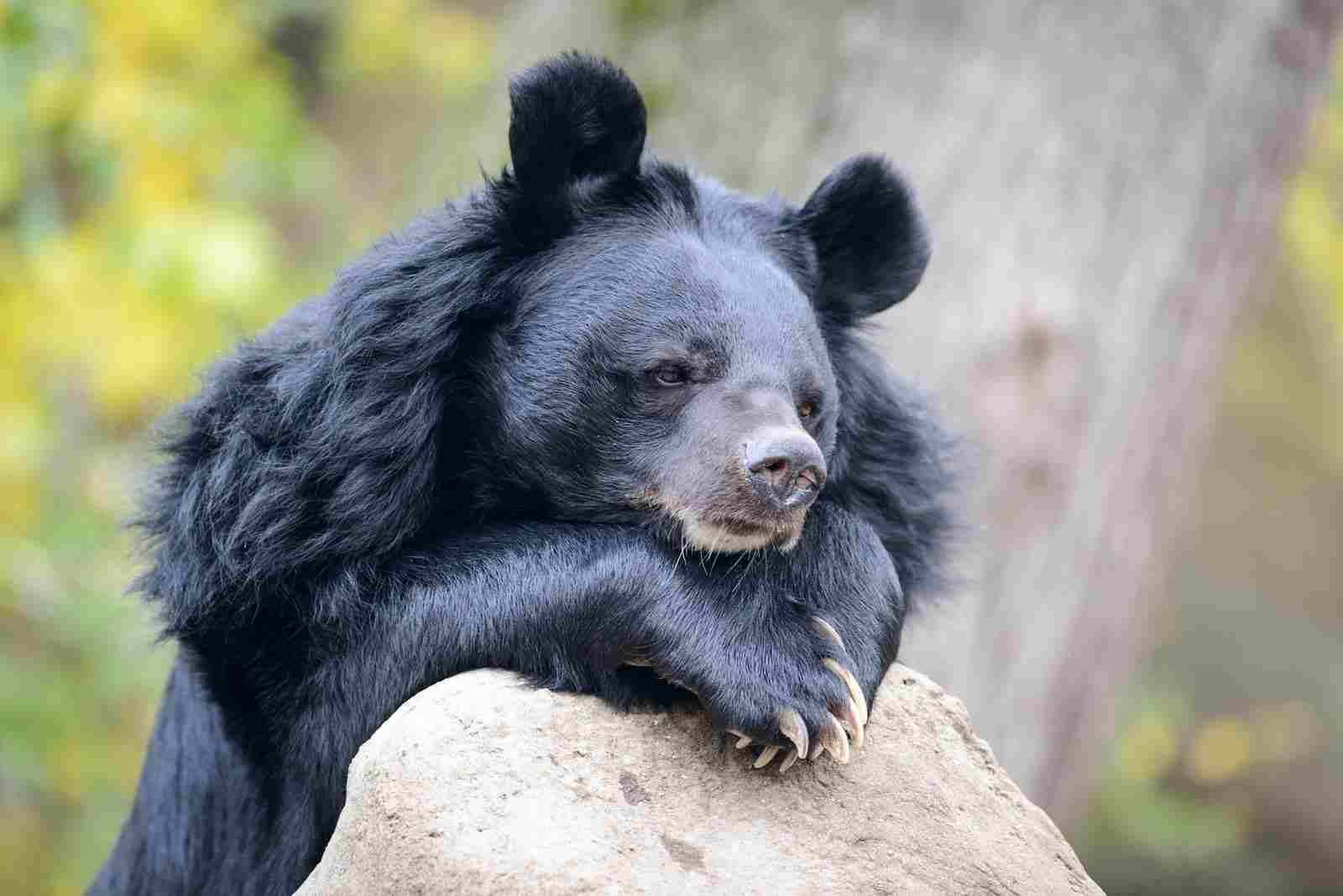
Sun Bear:
Short, sleek fur; usually black with a distinctive, pale orange or yellow chest marking shaped like a horseshoe.
Small and stocky build with a short snout and round ears.
Moon Bear:
Shaggy, black fur; distinctive V-shaped white or cream-colored chest mark.
Larger and more robust compared to the sun bear, with a longer snout and larger ears.
Comparison:
Sun bears have a shorter, sleeker appearance, while moon bears exhibit a shaggier and larger build.
Ecological Implications:
Fur coloration and markings may serve ecological purposes, such as camouflage or communication within their habitats.
3. Size
Sun Bear:
Length: 120-150 cm (47-59 inches)
Shoulder Height: 70 cm (28 inches)
Moon Bear:
Length: 120-190 cm (47-75 inches)
Shoulder Height: 70-100 cm (28-39 inches)
Comparison:
Moon bears are generally larger in size compared to sun bears.
Ecological Implications:
Size differences may influence their roles within ecosystems, affecting interactions with other species and resource utilization.
4. Weight
Sun Bear:
27-80 kg (60-176 lbs)
Moon Bear:
60-200 kg (132-440 lbs)
Comparison:
Moon bears are significantly heavier than sun bears.
Ecological Implications:
Weight differences may impact energy requirements, feeding habits, and competition for resources within their respective environments.
5. Bite Force (PSI)
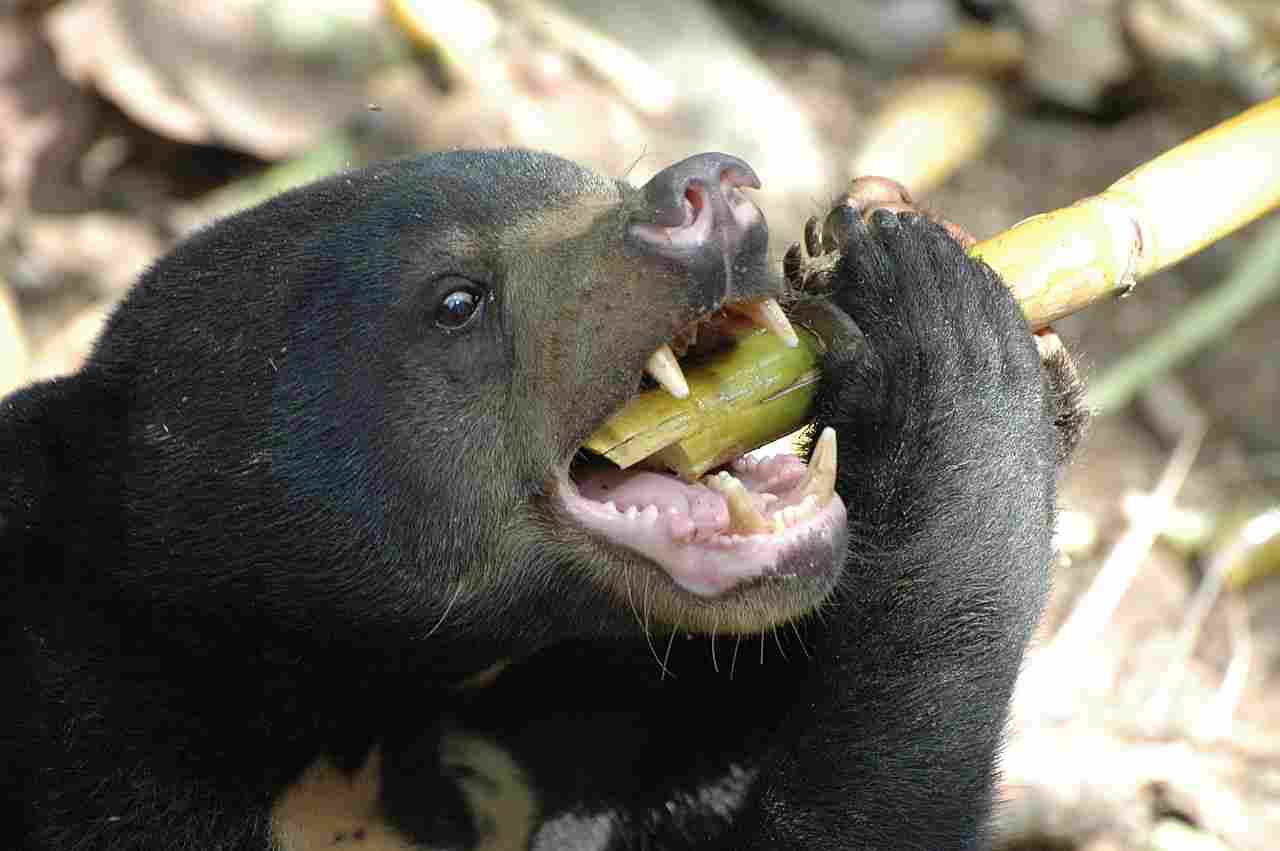
Sun Bear:
PSI not precisely measured, but estimated to be moderate.
Moon Bear:
PSI not precisely measured, but they are known to have a powerful bite.
Comparison:
Moon bears likely have a stronger bite force compared to sun bears.
Ecological Implications:
Bite force can influence hunting capabilities, feeding preferences, and interactions with prey or competitors in their ecosystems.
6. Physical Offensive Advantages
Sun Bear:
Sharp claws and teeth for efficient climbing and hunting small prey.
Well-adapted for accessing termite nests and extracting insects.
Moon Bear:
Powerful limbs and claws suitable for digging, climbing, and breaking open beehives.
Strong jaw and teeth for a diverse diet, including plant material, small animals, and insects.
Comparison:
Both bears possess physical adaptations for offensive actions, with specific features tailored to their ecological roles.
Ecological Implications:
These adaptations contribute to their effectiveness in foraging, hunting, and surviving in their respective habitats.
7. Physical Defensive Advantages
Sun Bear:
Agile and can escape predators by climbing trees.
Sharp claws and strong forelimbs can be used defensively.
Moon Bear:
Strong build and powerful limbs provide a defensive advantage against potential threats.
Climbing abilities aid in escaping predators or threats on the ground.
Comparison:
Both bears have evolved defensive mechanisms, utilizing their physical attributes to protect themselves.
Ecological Implications:
Defensive strategies influence their interactions with predators, competitors, and environmental challenges.
8. Speed (Km/hour or Mile/hour)
Sun Bear:
Estimated to reach speeds of 40 km/h (25 mph) for short bursts.
Moon Bear:
Agile and can move quickly, especially when motivated or threatened.
Comparison:
Sun bears may have slightly higher running speeds compared to moon bears.
Ecological Implications:
Speed impacts their ability to evade predators, catch prey, and navigate through their habitats.
9. Agility
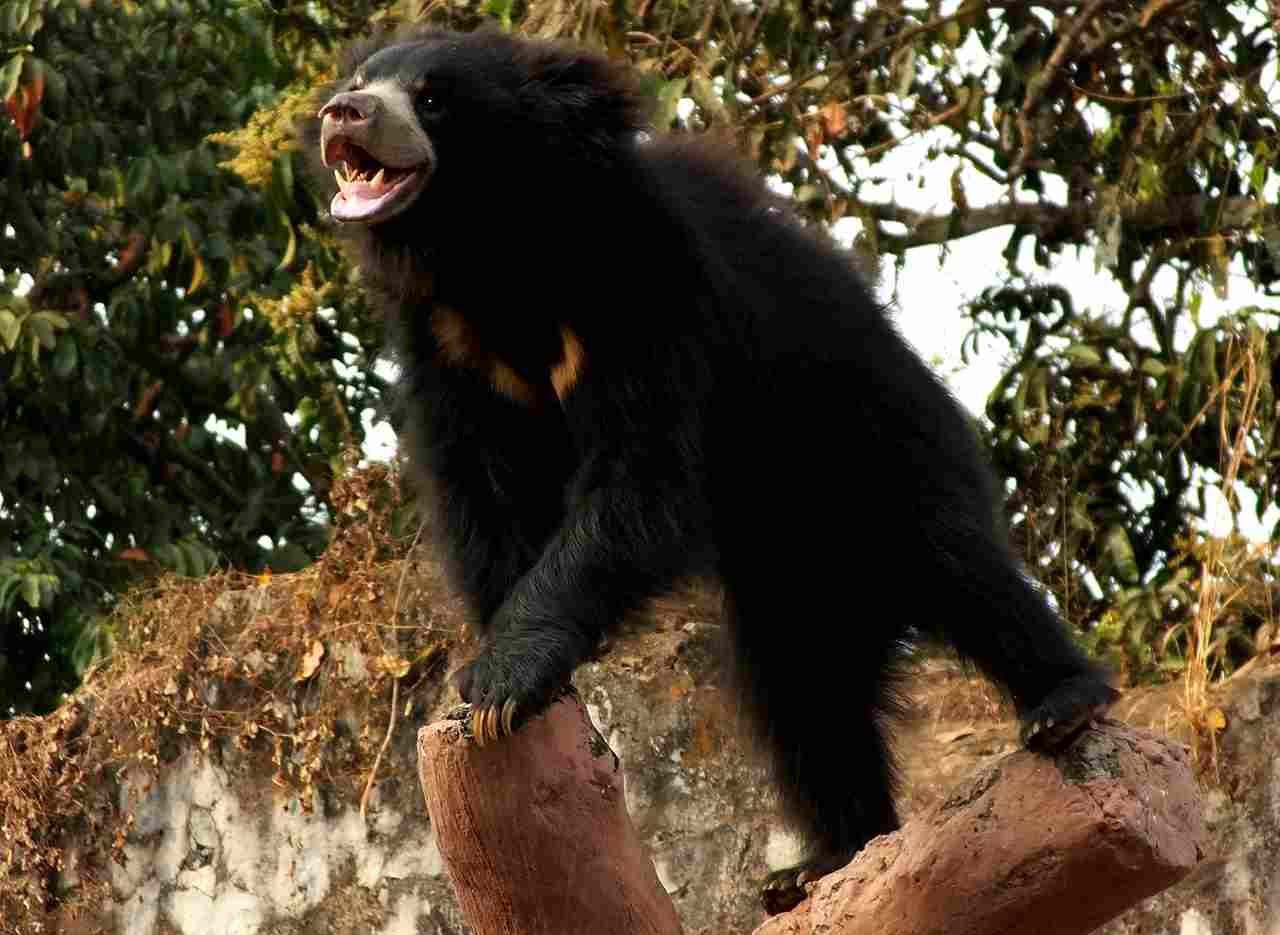
Sun Bear:
Agile climbers with strong limbs and sharp claws, well-suited for navigating trees.
Can maneuver through dense vegetation.
Moon Bear:
Agile climbers and swimmers, demonstrating versatility in various terrains.
Comparison:
Both bears exhibit agility, but sun bears are renowned for their climbing abilities, while moon bears excel in diverse terrains.
Ecological Implications:
Agility influences their access to food sources, escape from predators, and overall survival in their environments.
10. Overall Physical Capacity
Sun Bear:
Specialized for climbing with strong limbs and sharp claws.
Well-adapted for foraging on the forest floor and climbing trees in search of food.
Moon Bear:
Robust build with versatile limbs, allowing for efficient digging, climbing, and swimming.
Adapted to varied terrains, demonstrating strength and endurance.
Comparison:
Sun bears excel in climbing, while moon bears showcase a broader range of physical capacities, including digging and swimming.
Ecological Implications:
Their overall physical capabilities determine their ecological niche and impact their roles within their respective habitats.
11. Habitat Preference(s)
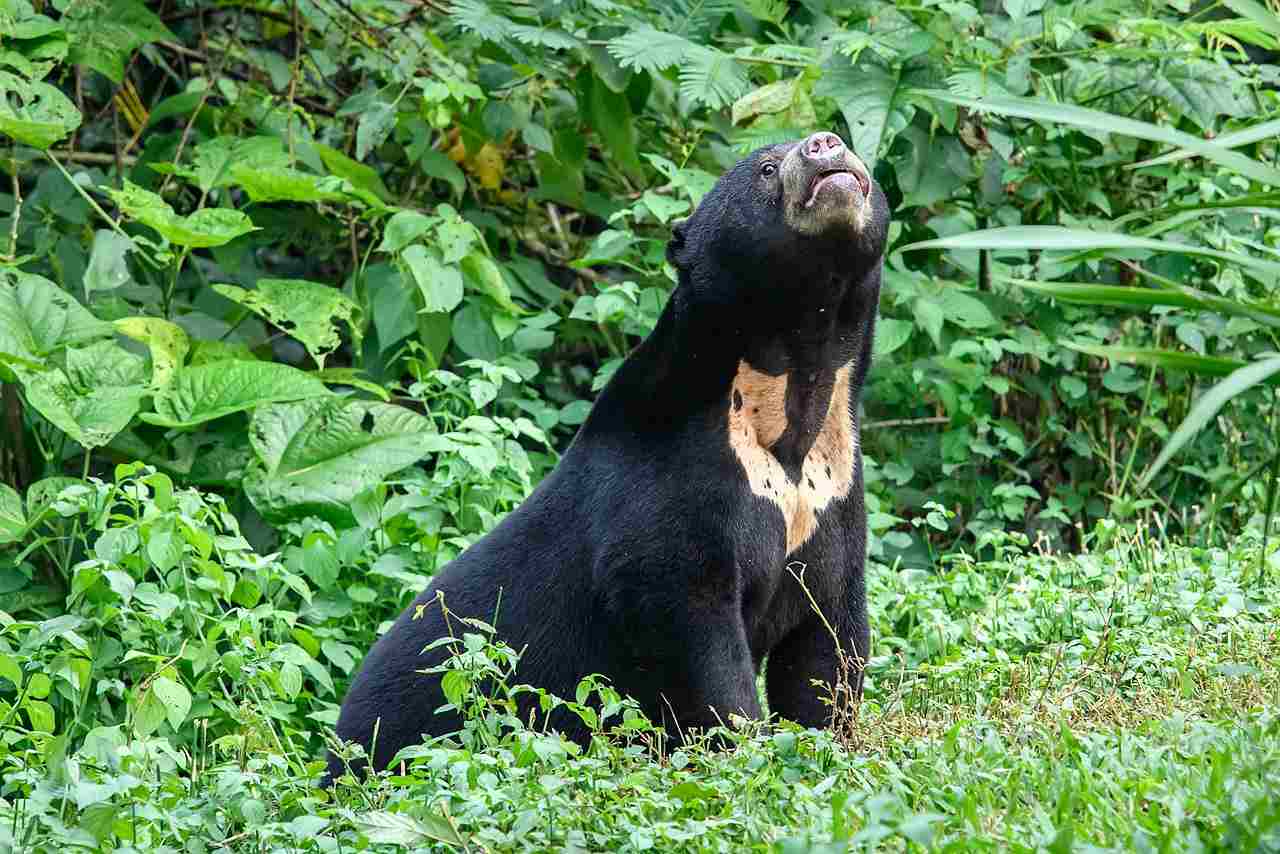
Sun Bear:
Dense tropical rainforests, preferring areas with abundant fruit trees.
Moon Bear:
Diverse habitats, including forests, mountains, and grasslands; adaptable to different elevations.
Comparison:
Sun bears exhibit a preference for tropical rainforests, while moon bears display adaptability to a broader range of habitats.
Ecological Implications:
Habitat preferences influence their interactions with other species, availability of resources, and overall ecosystem dynamics.
12. Tracks
Sun Bear:
Distinctive tracks with claw marks, reflecting their climbing adaptations.
Moon Bear:
Large, rounded tracks with prominent claw marks; indicative of their powerful limbs.
Comparison:
Track differences mirror their physical adaptations and can aid in identifying the presence of each bear species.
Ecological Implications:
Tracking methods contribute to monitoring and understanding their movements in the wild.
13. Lifespan
Sun Bear:
Approximately 25-30 years in captivity; lifespan in the wild is variable.
Moon Bear:
25-30 years in captivity; around 25 years in the wild.
Comparison:
Similar lifespans, influenced by factors such as habitat conditions, food availability, and threats in the wild.
Ecological Implications:
Lifespan variations may indicate differences in the challenges and environmental pressures faced by each species.
14. Mode of Feeding
Sun Bear:
Omnivorous diet, feeding on fruits, insects, small mammals, and honey.
Well-adapted for extracting insects from tree bark.
Moon Bear:
Omnivorous, consuming a diverse range of foods, including fruits, nuts, insects, small mammals, and vegetation.
Strong jaws allow them to access a variety of food sources.
Comparison:
Both bears are omnivores with a similar diet, adapting to the availability of resources in their habitats.
Ecological Implications:
Their feeding habits contribute to the balance of ecosystems, affecting plant and animal populations.
15. Intelligence
Sun Bear:
Demonstrates problem-solving skills and tool usage, especially in captivity.
Moon Bear:
Highly intelligent, capable of learning complex tasks and exhibiting problem-solving abilities.
Comparison:
Moon bears are often considered more intelligent, showing advanced cognitive abilities compared to sun bears.
Ecological Implications:
Intelligence influences their ability to adapt to environmental challenges, find food, and navigate their habitats.
16. Social Behavior
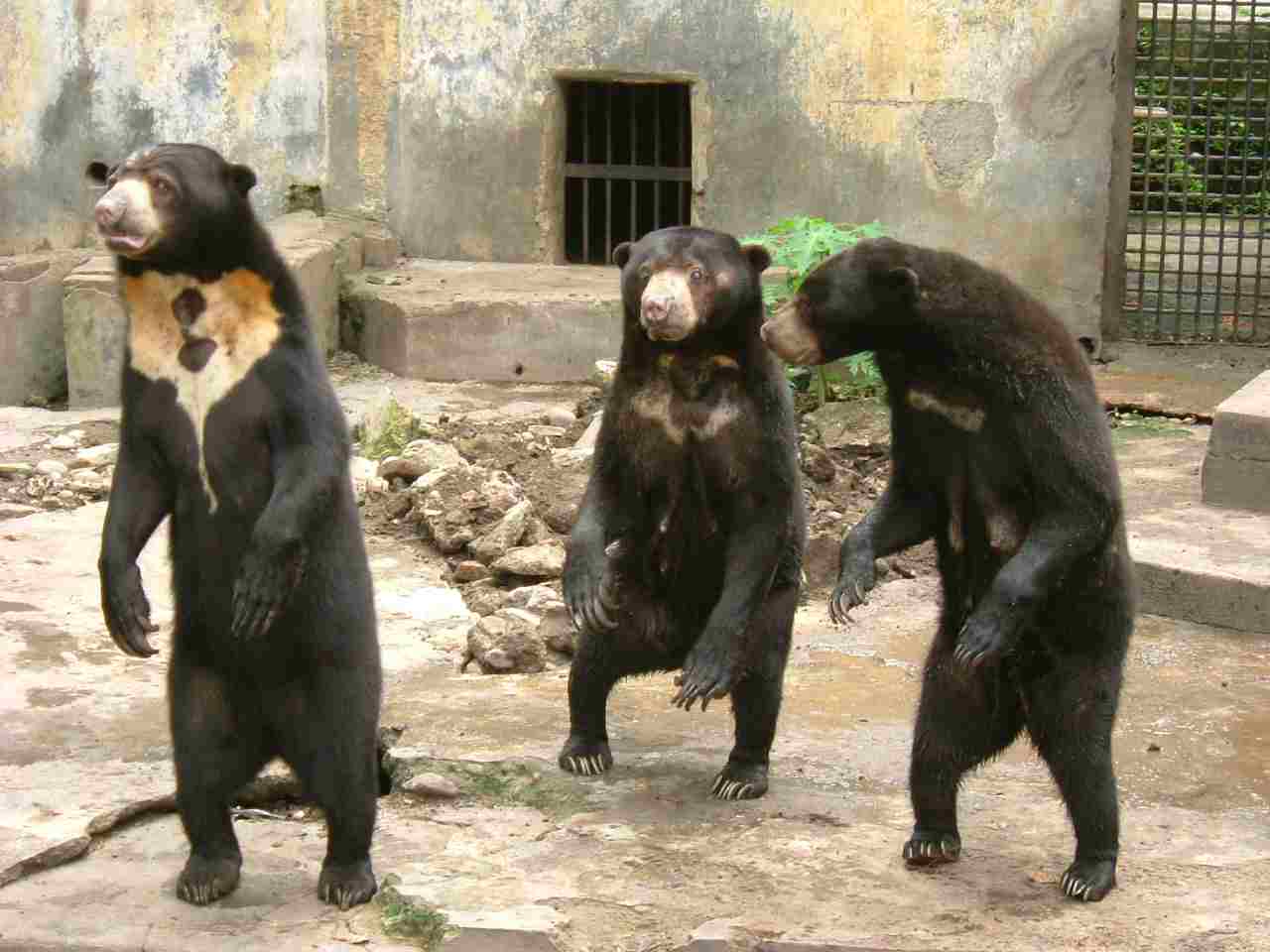
Sun Bear:
Generally solitary, but some social interactions observed, especially during the mating season.
Females with cubs may form family groups.
Moon Bear:
Typically solitary, but social interactions occur during the mating season and between mothers and cubs.
Comparison:
Both species exhibit primarily solitary behavior with some social interactions during specific periods.
Ecological Implications:
Social behaviors impact mating dynamics, competition for resources, and overall population dynamics.
17. Mode of Reproduction
Sun Bear:
Seasonal breeding; females give birth to one or two cubs after a gestation period of about 95-100 days.
Moon Bear:
Breeding season varies, and females give birth to one or two cubs after a gestation period of approximately 95-200 days.
Comparison:
Both species have a similar reproductive strategy with the birth of one or two cubs after a gestation period.
Ecological Implications:
Reproductive patterns influence population dynamics and genetic diversity within their respective habitats.
18. Parental Behavior
Sun Bear:
Females exhibit protective maternal behavior, caring for cubs until they become independent.
Males do not play a direct role in raising offspring.
Moon Bear:
Mothers provide care and protection to cubs, teaching them essential survival skills.
Males are not involved in cub rearing.
Comparison:
Both species display maternal care, with females taking the primary role in raising and protecting their cubs.
Ecological Implications:
Parental behavior influences cub survival rates and contributes to the overall health of the population.
19. Proximity to Human-Inhabited Areas
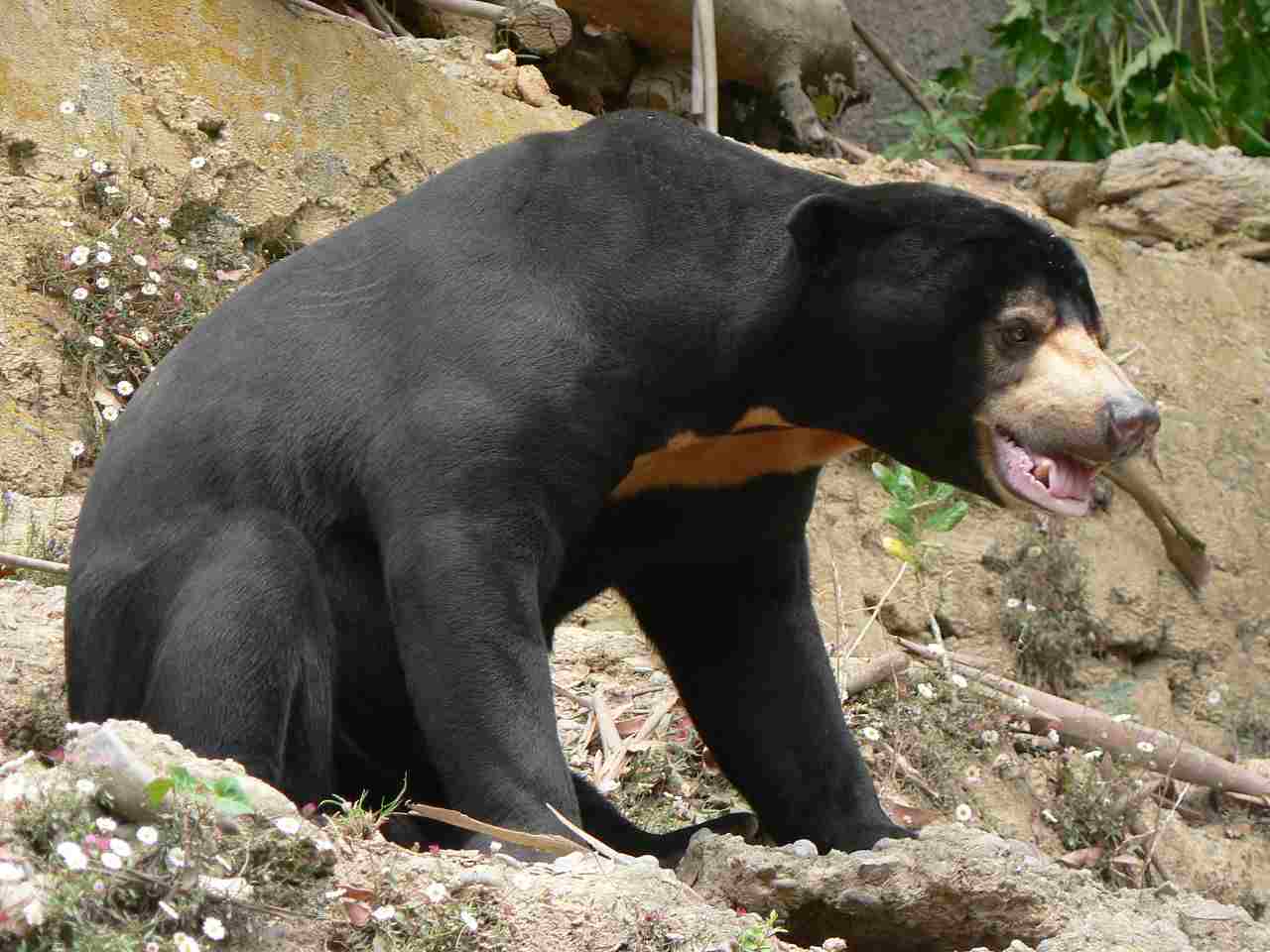
Sun Bear:
Found in proximity to human settlements, especially in areas with habitat fragmentation.
Can be attracted to agricultural areas in search of food.
Moon Bear:
May inhabit areas near human settlements, particularly if food resources are available.
Can be attracted to crops and villages in search of food.
Comparison:
Both bears may come into contact with human-inhabited areas, posing potential challenges for human-wildlife conflict.
Ecological Implications:
Human proximity can impact their behavior, movement patterns, and survival due to increased risks and potential conflicts.
20. Behavior Toward Humans
Sun Bear:
Generally shy and elusive but may exhibit aggression if cornered or threatened.
Can become habituated to human presence in certain situations.
Moon Bear:
Typically shy, but encounters can result in defensive behaviors.
Can become habituated to human presence, posing potential risks.
Comparison:
Both species tend to avoid humans but can display defensive behavior if provoked or feel threatened.
Ecological Implications:
Interactions with humans impact the bears’ stress levels, behavior, and potential risks to both parties.
21. Danger Posed to Humans
Sun Bear:
Generally poses a lower risk to humans; attacks are rare but can occur if the bear feels threatened.
Moon Bear:
Low risk to humans; attacks are infrequent but may happen if the bear perceives a threat.
Comparison:
Both bears typically pose a low risk to humans, with attacks being rare and often a result of perceived threats.
Ecological Implications:
Human-bear conflicts can lead to negative perceptions and consequences for bear populations and human safety.
22. Associated Precautions
Sun Bear:
Conservation efforts focus on habitat protection, reducing human-bear conflicts, and promoting responsible ecotourism.
Public awareness campaigns to educate communities on coexistence and minimizing risks.
Moon Bear:
Conservation measures include habitat preservation, reducing illegal hunting, and mitigating human-bear conflicts.
Educational programs to inform communities about safety measures and the importance of bear conservation.
Comparison:
Both species benefit from conservation strategies that involve habitat protection, conflict reduction, and community education.
Ecological Implications:
Successful precautions contribute to the conservation of bear populations and their ecosystems.
23. Conservation Status
Sun Bear:
Vulnerable on the IUCN Red List, facing threats from habitat loss, illegal hunting, and the pet trade.
Moon Bear:
Vulnerable on the IUCN Red List, primarily due to habitat destruction, hunting for body parts, and bile extraction.
Comparison:
Both species share a vulnerable conservation status, emphasizing the urgent need for conservation efforts.
Ecological Implications:
Their conservation status reflects the broader challenges facing bear populations and highlights the importance of habitat protection and sustainable practices.
Summary of Comparison
Taxonomy:
Sun Bear: Helarctos malayanus
Moon Bear: Ursus thibetanus
Appearance:
Sun Bear: Short, sleek fur, distinctive chest marking.
Moon Bear: Shaggy black fur, V-shaped chest mark, larger build.
Size:
Sun Bear: 120-150 cm (length)
Moon Bear: 120-190 cm (length)
Weight:
Sun Bear: 27-80 kg
Moon Bear: 60-200 kg
Bite Force (PSI):
Sun Bear: Moderate (estimated)
Moon Bear: Strong
Physical Offensive Advantages:
Sun Bear: Climbing adaptations, efficient insect extraction.
Moon Bear: Powerful limbs, claws for digging and climbing.
Physical Defensive Advantages:
Sun Bear: Agile climbing, defensive claws.
Moon Bear: Strong build, defensive limbs.
Speed:
Sun Bear: Approximately 40 km/h (25 mph)
Moon Bear: Agile and quick, not precisely measured.
Agility:
Sun Bear: Agile climber, dense vegetation navigator.
Moon Bear: Agile climber and swimmer.
Overall Physical Capacity:
Sun Bear: Climbing specialization.
Moon Bear: Versatile – digging, climbing, swimming.
Habitat Preference(s):
Sun Bear: Dense tropical rainforests.
Moon Bear: Diverse habitats, adaptable.
Tracks:
Sun Bear: Claw marks, climbing adaptations.
Moon Bear: Large, rounded tracks, powerful limbs.
Lifespan:
Sun Bear: Approximately 25-30 years (captivity)
Moon Bear: Around 25 years (wild)
Mode of Feeding:
Sun Bear: Omnivorous – fruits, insects, small mammals.
Moon Bear: Omnivorous – fruits, nuts, insects, small mammals.
Intelligence:
Sun Bear: Problem-solving skills, tool usage.
Moon Bear: Highly intelligent, complex task learning.
Social Behavior:
Sun Bear: Generally solitary, some social interactions.
Moon Bear: Typically solitary, social during mating and with cubs.
Mode of Reproduction:
Sun Bear: Seasonal breeding, one or two cubs.
Moon Bear: Variable breeding season, one or two cubs.
Parental Behavior:
Sun Bear: Maternal care, females primary caregivers.
Moon Bear: Mothers provide care and protection.
Proximity to Human-Inhabited Areas:
Sun Bear: Found near human settlements, especially in fragmented habitats.
Moon Bear: May inhabit areas near humans, adaptable.
Behavior Toward Humans:
Sun Bear: Generally shy, may exhibit aggression if threatened.
Moon Bear: Typically shy, defensive if provoked.
Danger Posed to Humans:
Sun Bear: Low risk, attacks rare.
Moon Bear: Low risk, attacks infrequent.
Associated Precautions:
Both: Conservation efforts include habitat protection, reducing conflicts, and public awareness.
Conservation Status:
Both: Vulnerable on the IUCN Red List, facing threats from habitat loss and hunting.
Conclusion
I). Similarities:
Both sun bears and moon bears belong to the Ursidae family, exhibit omnivorous diets, have similar reproductive strategies, and face vulnerability in terms of conservation status.
II). Differences:
Differences include physical characteristics, size, habitat preferences, intelligence levels, and specific ecological adaptations, influencing their roles within their respective ecosystems.
These distinctions underscore the importance of tailored conservation approaches to address the unique needs and challenges faced by sun bears and moon bears.

